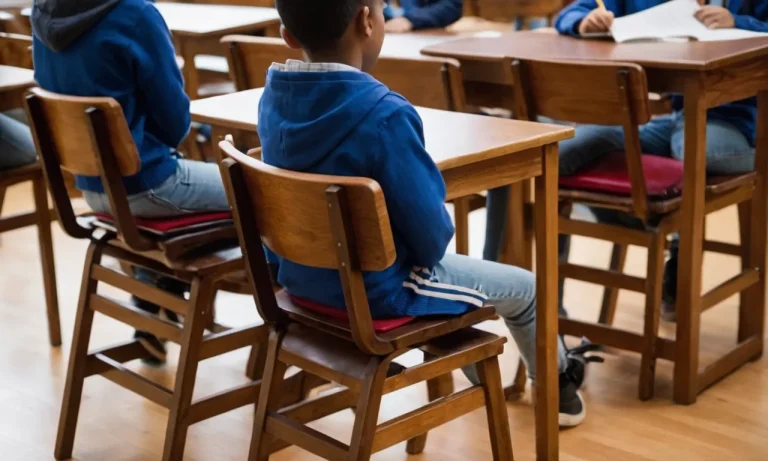Skipping school might seem like a harmless act of rebellion, but the consequences can be far-reaching and severe. In many parts of the world, education is not just a privilege but a legal obligation, and failure to comply with compulsory attendance laws can lead to serious penalties.
If you’re short on time, here’s a quick answer to your question: Yes, in some cases, you can go to jail for not going to school. Truancy laws vary from state to state, but most jurisdictions impose fines, community service, or even jail time for chronic absenteeism.
In this comprehensive article, we’ll delve into the legal ramifications of skipping school, explore the reasons behind compulsory education laws, and provide insights into the potential consequences for both students and their parents or guardians.
We’ll also discuss alternative solutions and strategies to address truancy issues.
Understanding Compulsory Education Laws
What are compulsory education laws?
Compulsory education laws, also known as mandatory attendance laws, are legal requirements that mandate children within a certain age range to attend school or receive equivalent instruction. These laws aim to ensure that all children receive a basic education, fostering their intellectual, social, and personal development.
The specifics of these laws, however, can vary significantly across different states and jurisdictions.
Variations in state laws
While the concept of compulsory education is universally accepted, the age range and requirements can differ from state to state. According to the Education Commission of the States, the typical age range for compulsory education is between 6 and 16 years old.
However, some states start as early as 5 or extend the requirement to 18 years of age. The specific ages and grade levels covered by compulsory education laws are determined by individual state legislatures.
In addition to age requirements, states may have varying rules regarding acceptable forms of education. While most states require attendance at a public or private school, some allow for homeschooling or alternative educational programs, provided they meet certain criteria.
It’s crucial for parents to familiarize themselves with their state’s specific laws and regulations.
Exceptions and exemptions
Although compulsory education laws aim to provide a universal education, there are certain exceptions and exemptions in place. For instance, most states allow exemptions for children with disabilities or special needs, provided they receive appropriate educational services tailored to their specific requirements.
Additionally, some states may grant exemptions for religious or philosophical reasons, but these exemptions can be subject to stringent requirements.
It’s important to note that failing to comply with compulsory education laws can result in legal consequences, such as fines or even potential jail time for parents or guardians. However, these consequences are typically reserved for cases of persistent and willful violation of the law, after attempts have been made to address the situation through alternative means, such as truancy intervention programs or family support services.
To stay informed and ensure compliance, parents and guardians are encouraged to consult with their local school district or state education authorities regarding the specific compulsory education laws and requirements in their area.
By understanding and adhering to these laws, families can help ensure that children receive the educational opportunities they deserve, setting them up for future success and personal growth. 😊
Consequences of Truancy
Fines and penalties
Missing school without a valid excuse, also known as truancy, can have serious legal consequences. Most states have laws that penalize students and their parents/guardians for unexcused absences. Depending on the state and the number of absences, parents may face hefty fines ranging from $100 to $500 or even jail time for repeat offenses.
For example, in Texas, parents can face fines up to $500 for truancy violations.
Jail time for chronic absenteeism
While it’s rare, some states do allow for jail time as a consequence for chronic truancy. In Indiana, parents can be jailed for up to 60 days if their child misses more than 10 days of school without a valid excuse.
However, jail time is typically reserved for the most extreme cases and is often seen as a last resort. Most states prefer to work with families and offer support services to address the underlying causes of truancy before resorting to legal action.
Impact on future opportunities
Beyond legal penalties, truancy can have a significant impact on a student’s future opportunities. Chronic absenteeism is linked to lower academic achievement, higher dropout rates, and decreased chances of pursuing higher education or finding well-paying jobs.
According to a study by the National Center for Education Statistics, students who missed more than 10% of school days were less likely to graduate from high school. 😔 Additionally, employers often view consistent attendance as a sign of responsibility and commitment, so a history of truancy can raise red flags during the hiring process.
👎
The consequences of truancy are far-reaching and can have a lasting impact on a student’s life. It’s crucial for students and their families to understand the importance of regular school attendance and seek support if they are struggling with attendance issues.
By addressing truancy early on, students can avoid legal penalties and increase their chances of academic success and future opportunities. 🎉
Responsibilities of Parents and Guardians
Legal obligations
Parents and guardians have a legal responsibility to ensure their children receive an education. In most states, it’s compulsory for children between certain ages (usually 6-16 or 18) to attend school regularly.
Failure to comply with these laws can result in legal consequences, such as fines or even criminal charges for educational neglect. According to the U.S. Department of Education, over 8 million students missed at least 10% of school days in 2015-16, highlighting the widespread issue of chronic absenteeism.
Potential consequences for enabling truancy
Parents or guardians who enable or contribute to their child’s truancy can face serious consequences. These may include fines, community service, or even jail time in extreme cases. For example, in Texas, parents can be fined up to $500 for each unexcused absence, while in California, they can face up to a year in jail and a $2,000 fine.
It’s crucial for parents to understand the gravity of the situation and take proactive measures to ensure their child’s regular school attendance. 🚨
Strategies for promoting school attendance
- Establish a consistent morning routine and bedtime to ensure your child gets enough sleep and is ready for school.
- Communicate regularly with teachers and school administrators to address any issues or concerns that may be impacting your child’s attendance.
- Encourage your child to participate in extracurricular activities or clubs to foster a sense of belonging and engagement with the school community.
- Seek support from counselors, social workers, or community organizations if your child is struggling with mental health, bullying, or other issues that may be contributing to absenteeism.
- Celebrate and reward your child’s positive attendance habits to reinforce the importance of regular school attendance. 🎉
Remember, education is a fundamental right and a crucial investment in your child’s future. By prioritizing school attendance and working closely with educators and support systems, parents and guardians can help their children thrive academically and socially.
Don’t let truancy become a roadblock to your child’s success – take action today! 👍
Alternative Solutions and Interventions
Addressing underlying issues
Truancy is often a symptom of deeper underlying issues that need to be addressed. Instead of solely focusing on punitive measures, it’s crucial to understand the root causes behind a student’s absenteeism.
These could include mental health concerns, bullying, learning disabilities, family problems, or lack of motivation. By working closely with students, parents, and professionals like counselors and social workers, schools can identify and address these underlying factors.
This holistic approach not only improves attendance but also supports the overall well-being of the student.
According to a study by the Attendance Works initiative, schools that implemented comprehensive interventions to address barriers to attendance saw a significant reduction in chronic absenteeism rates.
For example, the Oakland Unified School District in California implemented a multi-tiered system of support, including home visits, counseling, and mentoring programs, resulting in a 24% decrease in chronic absenteeism over three years.
Truancy prevention programs
Proactive truancy prevention programs can be highly effective in keeping students engaged and motivated to attend school. These programs often involve a combination of strategies, such as:
- Early intervention and monitoring of attendance patterns
- Incentives and rewards for good attendance
- Mentoring and peer support groups
- Engaging extracurricular activities and after-school programs
- Parental involvement and education on the importance of attendance
A study by the WestEd research organization found that schools implementing comprehensive truancy prevention programs saw an average reduction in chronic absenteeism rates of 15%. Additionally, these programs often lead to improved academic performance, increased graduation rates, and a more positive school climate.
Restorative justice approaches
Instead of relying solely on punitive measures, restorative justice approaches aim to repair the harm caused by truancy and address the underlying issues. This approach involves bringing together the student, parents, school staff, and sometimes community members to have open and honest discussions about the impact of truancy and to develop a plan for moving forward.
Restorative justice practices can include:
- Restorative circles or conferences
- Peer mediation
- Community service or restitution
- Developing a personalized attendance plan
According to a report by the Vera Institute of Justice, schools that implemented restorative justice approaches saw a significant reduction in suspensions and expulsions, as well as improved attendance rates.
For example, the Oakland Unified School District reported a 24% decrease in chronic absenteeism after implementing a restorative justice program.
By focusing on alternative solutions and interventions, schools can address the root causes of truancy and provide students with the support they need to succeed. Isn’t it amazing how a holistic and compassionate approach can make such a positive impact?
😊 With the right strategies in place, we can help ensure that every student has the opportunity to thrive academically and personally.
Conclusion
Skipping school might seem like a harmless act of defiance, but the consequences can be severe, ranging from fines and community service to potential jail time for chronic absenteeism. Compulsory education laws exist to ensure that every child receives a quality education, which is crucial for their personal growth and future success.
While the legal ramifications of truancy can be harsh, it’s important to recognize that these measures are often a last resort. By addressing underlying issues, promoting positive school environments, and implementing effective truancy prevention programs, we can work towards fostering a culture of learning and engagement, where students feel motivated and supported in their educational journey.






